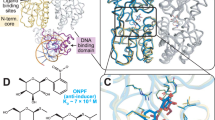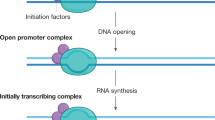Abstract
SEVERAL reports have considered the represser binding sites in the lac1–3 and λ4–6 operators. The analysis of these regions has focused on features apparent in the linear sequences such as regions of twofold rotational symmetry, and the 17-base-pair sequence which is largely conserved in the rightward and leftward represser-binding sites of λ6. As these sequences are thought to be wound in the double helical form when they are recognised by represser7,8, I have investigated whether any further interesting features could be revealed by such an arrangement.
This is a preview of subscription content, access via your institution
Access options
Subscribe to this journal
Receive 51 print issues and online access
$199.00 per year
only $3.90 per issue
Buy this article
- Purchase on Springer Link
- Instant access to full article PDF
Prices may be subject to local taxes which are calculated during checkout
Similar content being viewed by others
References
Gilbert, W., and Maxam, A., Proc. natn. Acad. Sci. U.S.A., 70, 3581–3584 (1973).
Dickson, R., Abelson, J., Barnes, W., and Reznikoff, W., Science 187, 27–35 (1975).
Gilbert, W., Maizels, N. M., and Maxam, A., Cold Spring Harb. Symp. quant. Biol., 38, 845–855 (1973).
Maniatis, T., Ptashne, M., Barrell, B. G., and Donelson, J., Nature, 250, 394–397 (1974).
Pirrotta, V., Nature, 254, 114–117 (1975).
Maniatis, T., et al., Cell, 5, 109–113 (1975).
Maniatis, T., and Ptashne, M., Proc. natn. Acad. Sci. U.S.A., 70, 1531–1535 (1973).
Wang, J. C., Barkley, M. D., and Bourgeois, S., Nature, 251, 247–249 (1974).
Feughelman, M., et al., Nature, 175, 834–838 (1955).
Sugimoto, K., Okamoto, T., Sugisaki, H., and Takanami, M., Nature, 253, 410–414 (1975).
Sekiya, T., and Khorana, H. G., Proc. natn. Acad. Sci. U.S.A., 71, 2978–2982 (1974).
Bertrand, K., et al., Science, 189, 22–26 (1975).
Blattner, F., Dahlberg, J., Boettiger, J., Fiandt, M., and Szybalski, W., Nature new Biol., 237, 232–236 (1972).
Schafer, R., Zillig, W., and Zechel, K., Eur. J. Biochem., 33, 207–214 (1973).
Loewen, P., Sekiya, T., and Khorana, H., J. biol. Chem., 249, 217–226 (1974).
Pribnow, D., Proc. natn. Acad. Sci U.S.A., 72, 784–788 (1975).
Britten, R. J., and Davidson, E. H., Science, 165, 349–358 (1969).
Author information
Authors and Affiliations
Rights and permissions
About this article
Cite this article
O'NEILL, M. Similarities in the helical sequences of the represser-binding sites in the lac and λ operators. Nature 260, 550–554 (1976). https://doi.org/10.1038/260550a0
Received:
Accepted:
Issue Date:
DOI: https://doi.org/10.1038/260550a0
Comments
By submitting a comment you agree to abide by our Terms and Community Guidelines. If you find something abusive or that does not comply with our terms or guidelines please flag it as inappropriate.



